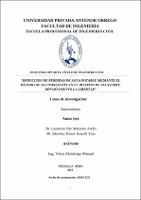Mostrar el registro sencillo del ítem
Reducción de pérdidas de agua potable mediante el método de sectorización en el distrito de Salaverry, departamento la libertad
| dc.contributor.advisor | Vertiz Malabrigo, Manuel Alberto | |
| dc.contributor.author | Guarnizo Paz, Marjorie Areliz | |
| dc.contributor.author | Sánchez Ponce, Araceli Tays | |
| dc.creator | Guarnizo Paz, Marjorie Areliz | |
| dc.date.accessioned | 2020-01-09T14:55:43Z | |
| dc.date.available | 2020-01-09T14:55:43Z | |
| dc.date.issued | 2019 | |
| dc.identifier.uri | https://hdl.handle.net/20.500.12759/5897 | |
| dc.description.abstract | En el presente trabajo de investigación se plantea una estrategia que busca reducir las pérdidas de agua en el Distrito de Salaverry, Provincia de Trujillo – Departamento de La Libertad, mediante el método de sectorización. La justificada y creciente preocupación por mejorar el aprovechamiento del agua en los sistemas de abastecimiento exige aumentar la calidad y rendimiento de dichos sistemas. En el presente proyecto, mediante un planteamiento de acciones inmediatas tanto en el ámbito comercial como operacional, se busca el incremento de la continuidad, reducción de agua no facturada, aumento de la cobertura de agua e incremento de ingresos mensuales en la EPS. Estas acciones inmediatas se determinaron después de un análisis técnico y teórico, que tuvieron como base la etapa de recopilación de datos in situ y de la EPS, y, la etapa de campo donde se analizó la infraestructura actual del servicio de agua, encontrando déficits en las redes existentes de agua. La ejecución de este proyecto conlleva a una gran inversión económica pero que a largo plazo convendría a la EPS ejecutarlo, ya que reduciría en un 60% las pérdidas de agua potable del Distrito de Salaverry, con respecto a los índices de pérdidas actuales; teniendo en cuenta, que las perdidas reales presentan mayor incidencia en comparación con las perdidas aparentes, y con ello, es importante saber diferenciarlas. | es_PE |
| dc.description.abstract | In the present research work, a strategy is proposed that seeks to reduce water losses in the District of Salaverry, Province of Trujillo - Department of La Libertad, by means of the sectorization method. The justified and growing concern to improve the use of water in the supply systems requires increasing the quality and performance of these systems. In the present project, by means of an approach of immediate actions in both the commercial and operational areas, the increase in continuity, reduction of unbilled water, increase in water coverage and increase of monthly income in the EPS is sought. These immediate actions were determined after a technical and theoretical analysis, which was based on the stage of data collection in situ and the EPS, and the field stage where the current infrastructure of the water service was analyzed, finding deficits in existing water networks. The execution of this project leads to a large economic investment but in the long term it would be convenient for the EPS to execute it, since it would reduce by 60% the losses of drinking water of the Salaverry District, with respect to the rates of current losses; taking into account that real losses have a higher incidence compared to apparent losses, and with that, it is important to know how to differentiate them. | en_US |
| dc.description.uri | Tesis | es_PE |
| dc.format | application/pdf | es_PE |
| dc.language.iso | spa | es_PE |
| dc.publisher | Universidad Privada Antenor Orrego - UPAO | es_PE |
| dc.relation.ispartofseries | T_ING.CIVIL_1817 | |
| dc.rights | info:eu-repo/semantics/openAccess | es_PE |
| dc.source | Universidad Privada Antenor Orrego | es_PE |
| dc.source | Repositorio institucional - UPAO | es_PE |
| dc.subject | Sectorización | es_PE |
| dc.subject | Reducción de pérdidas | es_PE |
| dc.subject | Agua no facturada | es_PE |
| dc.subject | Pérdidas aparentes | es_PE |
| dc.title | Reducción de pérdidas de agua potable mediante el método de sectorización en el distrito de Salaverry, departamento la libertad | es_PE |
| dc.type | info:eu-repo/semantics/bachelorThesis | es_PE |
| thesis.degree.level | Título Profesional | es_PE |
| thesis.degree.grantor | Universidad Privada Antenor Orrego. Facultad de Ingeniería | es_PE |
| thesis.degree.name | Ingeniero Civil | es_PE |
| thesis.degree.discipline | Ingeniería Civil | es_PE |
Ficheros en el ítem
Este ítem aparece en la(s) siguiente(s) colección(es)
-
Ingeniería Civil [1085]

